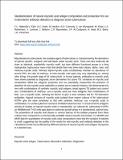| dc.description.abstract | Mycobacterium tuberculosis, the causative agent of tuberculosis, is characterized by the abundance of species specific, antigenic cell wall lipids called mycolic acids. These wax-like molecules all share an identical, amphiphilic mycolic motif, but have different functional groups in a long hydrophobic hydrocarbon mero-chain that divide them into three main classes: alpha-, keto- and methoxy-mycolic acids. Whereas alpha-mycolic acids constitutively maintain an abundance of around 50%, the ratio of methoxy- to keto-mycolic acid types may vary depending on, among other things, the growth stage of M. tuberculosis. In human patients, antibodies to mycolic acids have shown potential as diagnostic serum biomarkers for active TB. Variations in mycolic acid composition affect the antigenic properties and can potentially compromise the precision of detection of anti-mycolic acids antibodies in patient sera to natural mixtures. We demonstrate this here with combinations of synthetic mycolic acid antigens, tested against TB patient and control sera. Combinations of methoxy- and α-mycolic acids are more antigenic than combinations of keto- and α-mycolic acids, showing the former to give a more sensitive test for TB biomarker antibodies. Natural mixtures of mycolic acids isolated from mature cultures of M. tuberculosis H37Rv give the same sensitivity as that with synthetic methoxy- and α-mycolic acids in combination, in a surface plasmon resonance inhibition biosensor test. To ensure that the antigenic activity of isolates of natural mycolic acids is reproducible, we cultured M. tuberculosis H37Rv on Middlebrook 7H10 solid agar plates to stationary growth phase in a standardized, optimal way. The proportions of mycolic acid classes in various batches of the isolates prepared from these cultures were compared to a commercially available natural mycolic acid isolate. LC-MS/MS and NMR data for quantitation of mycolic acids class compositions show that the variation in batches is small, suggesting that the quality of the results for anti-mycolic acid antibody detection in the TB patients should not be affected by different batches of natural mycolic acid antigens if prepared in a standard way. | en_US |

